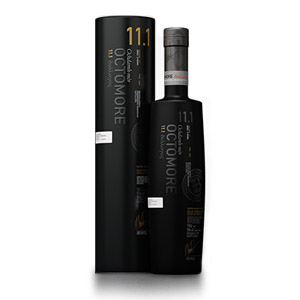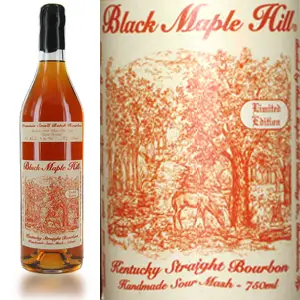A few times I year I start thinking about refining my approach to this blog. First, I think, “Maybe I should only review age-stated whiskies.” This idea is quickly quashed when I remember that would shut the door on favorites like Aberlour a’bunadh, Ardbeg Corryvreckan, etc. My next thought is “Maybe I should only review producers that make their own whisky.” This takes some thinking…
I could avoid something like 80% of the bottles in the American whiskey section at the store, for instance. Talk about a taking a load off of my mind. Almost all of these are LDI/MGP spirit anyway, so I’ve been essentially reviewing the same damn whiskey over and over again for years. But then I’d miss out on some gems like Sagamore Spirit Rye and Angel’s Envy, and frankly I’d probably run out of stuff to review.
So here we are, today, once again taking a look at a well-marketed bourbon without the faintest clue as to where the liquid is actually distilled. At least Infuse Spirits, makers of the Broken Barrel brand as well as a slew of – hah – infused spirits, is trying to do something innovative. They are doing something similar to what John Glaser of Compass Box wanted to do with the original Spice Tree. He wanted to mature whiskey with oak staves inserted into the barrel, but the Scottish trade organization (SWA) stopped him. Since the rules in the US are looser nobody is stopping Infuse from dropping various staves into their tanks of already-aged bourbon. So when my quarterly Flaviar Subscription bottle choice came up, I picked a bottle of the Broken Barrel Cask Strength Bourbon.
A quick aside – I experimented several times with “home aging” kits that involved inserting sticks of various kinds of oak into small bottles of whisky. The results were mixed but my conclusion for each product was that it wasn’t worth the time, money, or effort. That said, there’s a huge difference in scale between a 250ml bottle with a 4-inch oak stick in it versus an entire steel tank with whole staves inside. It’s no surprise to me that the results differ.
So on to the whiskey. We have Kentucky Bourbon from a mash bill of 70% corn, 21% rye, and 9% malted barley. Neither the age nor the original distiller are published, although it does say a “minimum of one year in new charred oak”. It does not say “straight bourbon” on the bottle… perhaps the use of staves prevents the legal use of ‘straight bourbon’, or perhaps they didn’t want to wait the full 2 years of aging. This sourced bourbon is then ‘matured’ an extra period of time in large stainless steel tanks with various oak staves from other barrels dumped inside. Here’s the cool part: Each bottle lists an “oak bill” describing the percentage of each kind of oak used in the tank. My batch (Batch 006) has 40% ex-bourbon staves, 40% new French oak staves, and 20% staves from a sherry cask (probably sherry “seasoned“). The website does not say how many staves are used, nor does it say how long the whiskey spends in the tank.
This is a review of the Cask Strength bourbon, which is bottled at 58% ABV, but Broken Barrel also sells a 95 proof bourbon, a rye, and a “California Oak” bourbon with Cabernet wine cask staves.
Lastly, and this is irrelevant to the review but I had to mention it: The bottle has a convenient little leather strap around the neck which makes it SO EASY to pour into a glass. I now wish every bottle had one of these.
Nose: Strong nose tickle. Piercing notes of spicy ground cinnamon, dried cherries, and butterscotch. Oaky, with resinous notes of aged lumber, sap, and varnish. Fairly dry on the nose – not much sweetness.
Palate: Silky body. Robust tongue burn which hits immediately. Spicy, with significant rye spice notes of clove, cinnamon, star anise, and maraschino cherry. The sweetness of the corn finally comes through, with a fudgy kind of caramel-and-marshmallow (scotchmallow?) thing.
Finish: Medium-long and tannic. A reprise of the aroma notes – dry woods and spices. Evolves a bit of candy corn (honey / corn syrup) and dry cocoa powder before fading.
With Water: Several drops of water initially mute the aroma, necessitating a rest in the glass. The water adds a good amount of much-needed caramel sweetness and a delectable vanilla buttercream note. The palate burn is also reduced. I HIGHLY recommend adding water to this.
Overall: This is not a bad cask-strength bourbon. It’s a little on the dry side, but the sweetness does peek through in places where it’s needed for balance. I can’t detect anything specifically different as a result of the added staves, although there is a slight sandalwood-and-chocolate note that I associate with French oak. It is definitely heavily influenced by the rye, with spice-cabinet notes dominating.
This is also priced very well: $40 is not unreasonable for a tasty cask-strength bourbon. Some of the more “craft” American whiskies have started asking upwards of $70 for the same thing. Recognize, though, that you’re paying partially for gimmick. There are plenty of cask-strength bourbons available from the big produces for less. Still, I’m very happy with this one and would consider buying a second bottle, and I’m now pretty curious about the one with Cabernet staves…









Nice article. It is difficult to write a review about a specific category as some other important drinks will miss out. Cask Strength bourbon must be value for money. $40 is not unreasonable for this drink. Your review is in-depth. Thank you very much. Keep posting such reviews.